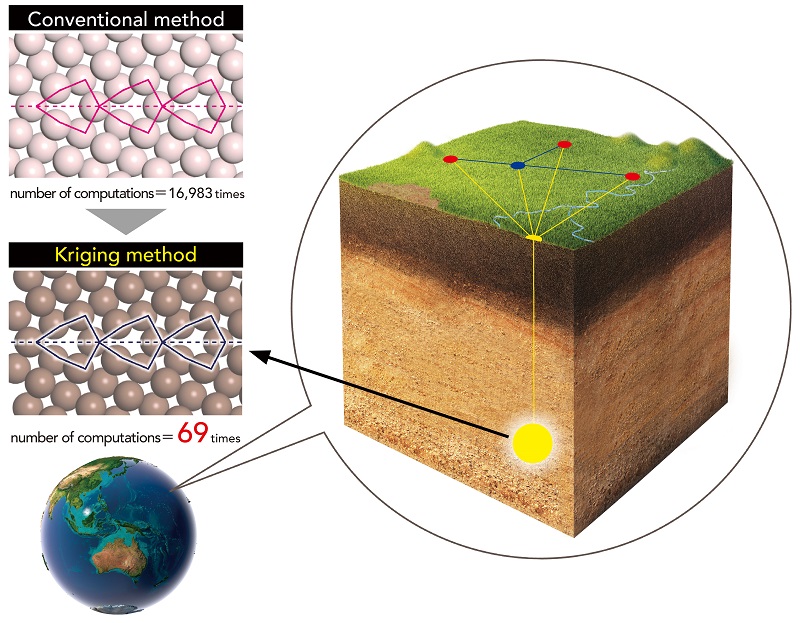100-fold increase in speed of determining interface structure Successful application of big data methodology


Schematic illustration of Kriging
In the geostatistics field of resources surveying, the location of underground resources have to be estimated efficiently from a small number of test borings. For instance, calculating the reserves from boring data at the red points, the blue point is chosen for further boring. Combining data from all the red and blue points in the figure, the Kriging method is used to estimate the location of the maximum reserves (yellow). By using this method, the research group successfully calculated the interface structure at a speed more than 100-fold faster than conventional methods.
© 2016 Teruyasu Mizoguchi.
Researchers at the University of Tokyo have succeeded in determining the structure of an interface between two materials at a speed 100-fold faster than conventional methods. This result was made possible by the application of big data methodologies to the field of resources surveying.
Big data techniques are utilized in a wide range of fields from finance to drug discovery. Research employing big data techniques is referred to as materials informatics within the field of materials science and is becoming a major trend, with major projects costing over 10 billion yen per year being carried out in the United States.
Interfaces are closely related to material properties, as can be seen in a battery or a catalyst. However, several thousands to tens of thousands of very computer-intensive calculations are necessary to determine even a single structure. Developing efficient methods to determine the interface structure without searching all possible combinations is extremely important in material science to speed up the development of high-performance materials.
The research group of graduate student Shin Kiyohara and Associate Professor Teruyasu Mizoguchi at the University of Tokyo Institute of Industrial Science has demonstrated a powerful method to rapidly determine the stable interface structure using a spatial interpolation method used in resources surveying known as Kriging. While several thousands to tens of thousands of calculations are necessary to search for the stable structure using conventional methods, the stable interface structure can be determined by only several tens to a hundred calculations using the group’s new approach. In addition, comparing the interface structure determined by the conventional and novel Kriging method, the same structure was obtained with only 1/246 the number of calculations.
“This study clearly demonstrates that the Kriging method is extremely versatile, and we found that it can be applied to any type of interface,” says Associate Professor Mizoguchi. He continues, “Material interfaces are closely related to material properties as can be seen in the cases of batteries and catalysts, so this method has tremendous potential to accelerate the development of high performance batteries and catalysts.”
Press release [PDF] (Japanese)
Paper
, "Acceleration of stable interface structure searching using a kriging approach", Japanese Journal of Applied Physics: 2016/03/06 (Japan time)
Article link (Publication)
Links
Institute of Industrial Science
Department of Materials Science, Graduate School of Engineering






